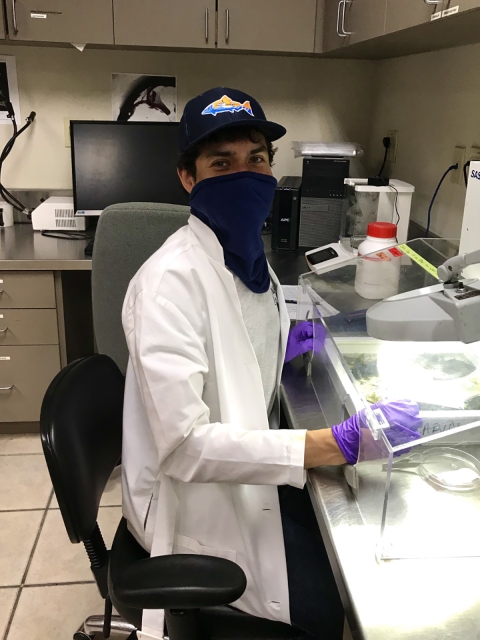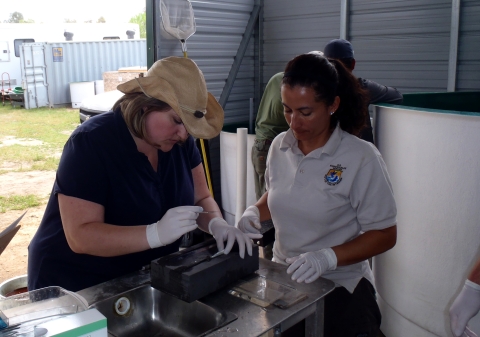Science Support Program, Lodi FWO
The Science Support Program in the Lodi Fish and Wildlife Office provides statistical, modeling and synthesis support for the office and the region. Among the many activities of this group, the Delta Smelt Life Cycle Model and Juvenile Salmon Survival Studies are just two examples.
Delta Smelt Life Cycle Model
Delta smelt are a small pelagic fish native to the San Francisco Bay-Delta that have undergone fluctuating population declines in recent decades while demands for Delta water exports have increased. The species, protected by the federal Endangered Species Act and California Endangered Species Act, is of high concern as an indicator species for the overall health of the Delta.
The Lodi Fish and Wildlife Office has a monitoring program designed to monitor Delta smelt and has assisted in the development of a Delta Smelt Life Cycle Model. The model is a quantitative tool designed to assess and predict the effects of management actions on the Delta smelt population, with the long-term goals of population recovery and sustainability.
In the future, this page will serve as a repository for an extensive collection of data sets collected for fitting the model, computer code generated in support of the model and reports describing various aspects of the model. Partners providing data and support include the California Department of Fish and Wildlife and U.S. Geological Survey. In many cases, data have been modified by the Fish and Wildlife Service and made available as csv formatted files, R formatted files, or both. Documentation of the modifications will also be made available.
If you are interested in information related to this effort, please email vanessa_tobias@fws.gov.
Juvenile Salmonid Survival Studies
The Lodi Office participates in large-scale, multi-agency, juvenile salmonid survival studies across California’s Central Valley, the Sacramento-San Joaquin River Delta and the San Francisco Estuary. Presently we are collaborating on projects tracking the survival and outmigration patterns of juvenile Chinook salmon from the Sacramento River basin through the north Delta and juvenile steelhead from the San Joaquin River basin through the south Delta.
These projects utilize acoustic telemetry to monitor and track individual fish after they are released. Fish are surgically implanted with a small acoustic tag that sends out signals, which are detected by receivers located within the Sacramento and San Joaquin rivers, the Delta and the San Francisco Estuary. Each tag has a unique code so we can monitor and track the status of individual fish as they migrate to the ocean. Our office is actively participating with partner agencies to tag and release juvenile salmonids throughout the Central Valley.
Our Partners
Our office participates in collaborative projects with federal partners including the Bureau of Reclamation, National Marine Fisheries Service and U.S. Geological Survey; state partners including the California Department of Water Resources and Department of Fish and Wildlife; and universities including the University of California, Santa Cruz, and UC, Davis. We are also active members in the Interagency Telemetry Advisory Group to coordinate tagging projects and maintenance of the acoustic receiver array, consisting of both real-time receivers (that transmit data each hour) and autonomous receivers (that collect data for an entire field season) to track tagged fish throughout the Central Valley.
Our office has been using acoustic telemetry methods to track survival and migration of juvenile salmonids since the mid-2000s and has benefitted from various partners assisting with the analyses, including the University of Washington and U.S. Geological Survey. Typical analyses for this type of data uses multi-state mark-recapture models to estimate reach and route survival through the Delta. The multi-state models allow us to separate the migration corridor into multiple reaches and routes (i.e., states) to assess various hypotheses on juvenile salmonid survival in the Delta, and to identify reaches of high relative mortality.
We have also partnered with the National Marine Fisheries Service and the California Department of Water Resources to evaluate predator control and relative predator mortality in the Delta. This information is used to inform managers and recommend management actions to improve juvenile salmon and steelhead survival as they migrate through the Delta.
Prior to using acoustic telemetry, we used coded-wire-tags to mark fish, and we recovered them in sampling downstream and in the ocean fishery to estimate survival through the Delta.
Articles and Reports
We have published many peer-reviewed journal articles, some of which can be viewed in this collection, as well as newsletter articles and agency reports with our partners.



